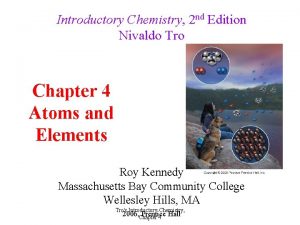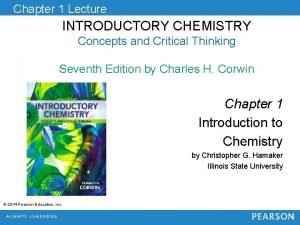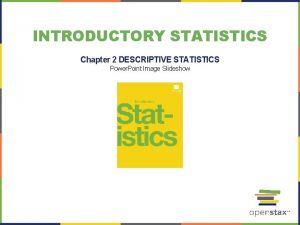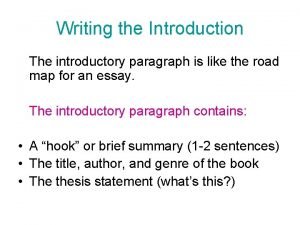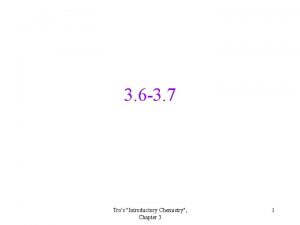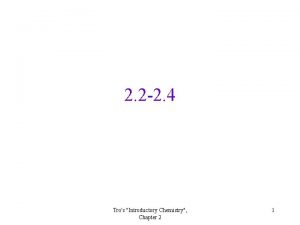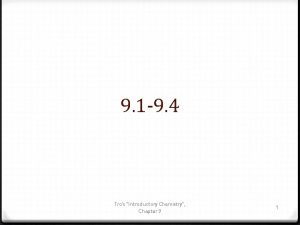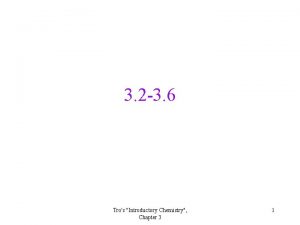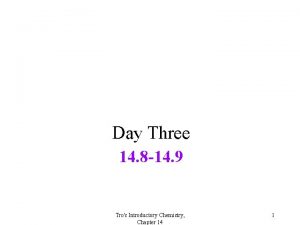1 Tros Introductory Chemistry Chapter 7 Tros Introductory








- Slides: 8

1 Tro's "Introductory Chemistry", Chapter 7

Tro's "Introductory Chemistry", Chapter 7 Practice—Write an Equation for the Reaction that Takes Place when an Aqueous Solution of ammonium sulfate is Mixed with an Aqueous Solution of lead (II) acetate. 2

Ionic Equations • Equations that describe the chemicals put into the water and the product molecules are called molecular equations. 2 KOH(aq) + Mg(NO 3)2(aq) ® 2 KNO 3(aq) + Mg(OH)2(s) • Equations that describe the actual dissolved species are called complete ionic equations. • Aqueous electrolytes are written as ions. • Soluble salts, strong acids, strong bases. • Insoluble substances and nonelectrolytes written in molecule form. • Solids, liquids, and gases are not dissolved, therefore, molecule form. 2 K+1(aq) + 2 OH-1(aq) + Mg+2(aq) + 2 NO 3 -1(aq) ® 2 K+1(aq) + 2 NO 3 -1(aq) + Mg(OH)2(s) 3 Tro's "Introductory Chemistry", Chapter 7

Writing Complete Ionic Equations Rewrite the molecular equation, but dissociate strong electrolytes into individual ions. • Strong electrolytes must be aqueous. • • • All soluble ionic compounds are strong electrolytes. Strong acids are strong electrolytes. • • • Solids, liquids, or gases cannot be electrolytes. HCl, HNO 3, H 2 SO 4. . Weak acids are not written in the dissociated ion form. Molecular compounds do not have ions, leave in the molecular form. Tro's "Introductory Chemistry", Chapter 7 • 4

Ionic Equations • Ions that are both reactants and products are called spectator ions. • An ionic equation in which the spectator ions are removed is called a net ionic equation. 2 OH-1(aq) + Mg+2(aq) ® Mg(OH)2(s) Tro's "Introductory Chemistry", Chapter 7 2 K+1(aq) + 2 OH-1(aq) + Mg+2(aq) + 2 NO 3 -1(aq) ® 2 K+1(aq) + 2 NO 3 -1(aq) + Mg(OH)2(s) 5

Writing Net Ionic Equations • First, identify the spectator ions in the complete ionic equation. • Cancel out the spectator ions—the result is the net ionic equation. Tro's "Introductory Chemistry", Chapter 7 • Identical ions on both sides of the equation. 6

• A molecular equation is a chemical equation showing the complete, neutral formulas for every compound in a reaction. • A complete ionic equation is a chemical equation showing all of the species as they are actually present in solution. • A net ionic equation is an equation showing only the species that actually participate in the reaction. Tro's "Introductory Chemistry", Chapter 7 Summary 7

Practice–Write the Ionic and Net Ionic Equation. Na 2 CO 3(aq) + 2 HCl(aq) ® 2 Na. Cl(aq) + CO 2(g) + H 2 O(l) Tro's "Introductory Chemistry", Chapter 7 K 2 SO 4(aq) + Ba(NO 3)2(aq) ® 2 KNO 3(aq) + Ba. SO 4(s) 8
 Introductory chemistry 4th edition
Introductory chemistry 4th edition Prefix multipliers
Prefix multipliers Introductory chemistry 5th edition answers
Introductory chemistry 5th edition answers Nivaldo j. tro introductory chemistry
Nivaldo j. tro introductory chemistry Introductory chemistry concepts and critical thinking
Introductory chemistry concepts and critical thinking Chapter 2 descriptive statistics answer key
Chapter 2 descriptive statistics answer key Ib organic chemistry
Ib organic chemistry Inorganic vs organic chemistry
Inorganic vs organic chemistry Purpose of introduction
Purpose of introduction



